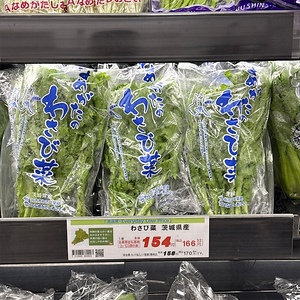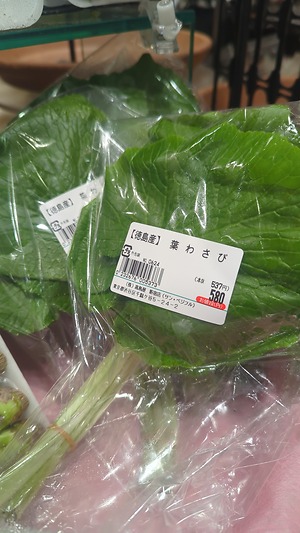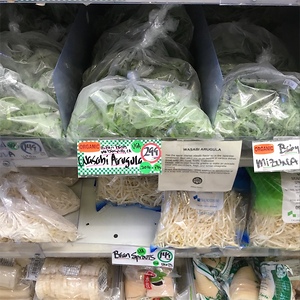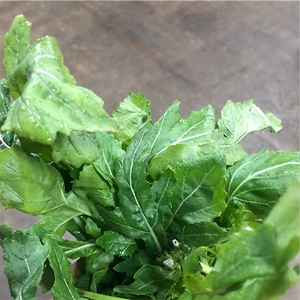

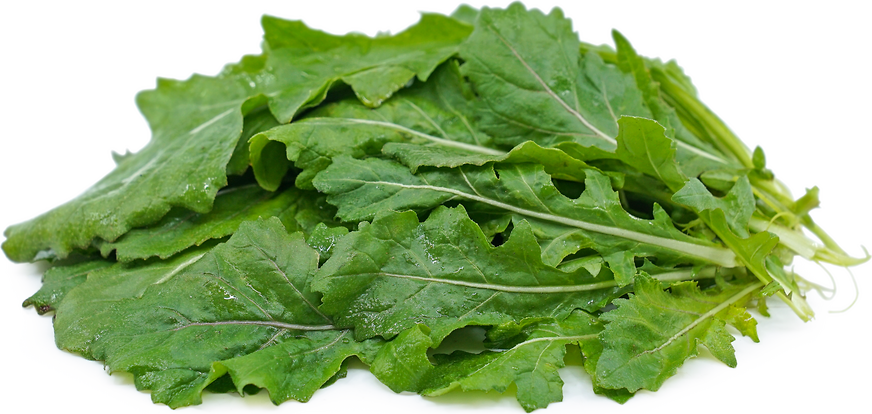
Wasabi Arugula
Estimated Inventory, 4 ct : 0
Description/Taste
Wasabi arugula is a small plant, averaging 10 to 20 centimeters in height, and contains many spoon-shaped leaves growing in a loose rosette. The leaves are smooth, broad, flat, and crisp, bearing serrated edges, and the dark green surface is covered in prominent veining. Attached to the leaves is a semi-thick, straight, and pale green stem providing a crunchy and succulent consistency. Wasabi arugula has an initially spicy, tangy bite, reminiscent of wasabi or horseradish, followed by subtly sweet, nutty, and slightly bitter undertones. It is important to note that the sharp flavors of Wasabi arugula are immediate and potent, but the nose-tingling feeling is less intense than true wasabi, and the spice dissipates quickly, leaving pleasant herbal flavors on the palate. Wasabi arugula also produces edible, white flowers that bear a faint sweet and sour, nutty taste.
Seasons/Availability
Wasabi arugula is available in the spring through fall.
Current Facts
Wasabi arugula is a member of the Diplotaxis genus and is a small, herbaceous plant belonging to the Brassicaceae or mustard family. The spicy green was developed from a wild arugula variety through natural, selective breeding, and the variety was designed to showcase a highly pungent flavor, reminiscent of wasabi root. Wasabi arugula is also known as Wasabi rocket in Europe, and despite the plant’s name, the term wasabi is solely a descriptor utilized for marketing purposes, and the two plants are not related. In the modern-day, the cultivar is primarily used by innovative chefs or is grown in home gardens as a novel variety. Wasabi arugula is eaten fresh or lightly cooked and can be harvested at multiple stages of maturity, offering a crisp consistency with a sharp flavor.
Nutritional Value
Wasabi arugula is an excellent source of vitamin A to strengthen the immune system, promote healthy organ functioning, and protect against vision loss. The greens are also a good source of vitamin C, an antioxidant that reduces inflammation and provides lower amounts of iron, calcium, and potassium.
Applications
Wasabi arugula has a spicy flavor well-suited for both raw and cooked applications. The leaves can be harvested when young as a baby green, or they can be left to fully mature, developing a slightly bitter undertone. Wasabi arugula can be used as a spicy substitute for common arugula in salads, sandwiches, soups, and stews. The greens can also be wilted into pasta, curries, and barbeque dishes or placed on top of pizza, noodle dishes, and omelets. In addition to wilting, Wasabi arugula can be layered into caprese, mixed into grain bowls, chopped into ceviche, wrapped into sushi, or blended into pesto. The plant's flowers are also edible and can be used as a garnish over soups, salads, and stir-fries. Wasabi arugula pairs well with seafood such as crab, scallops, salmon, bass, and tuna, meats such as poultry, prosciutto, sausage, and bacon, garlic, ginger, avocado, dill, cucumbers, sorrel, bell peppers, and mozzarella. Unwashed Wasabi arugula will keep for 3 to 10 days when wrapped in paper towels and stored in a container in the refrigerator.
Ethnic/Cultural Info
Wasabi arugula was selected as Thompson & Morgan’s vegetable of the year in 2017. Thompson & Morgan is one of the United Kingdom’s largest mail-order seed companies, established in 1855, and specializes in home garden plants. Wasabi arugula was selected for its subtly sweet, spicy, and nutty flavor, and the cultivar was planted in the Thompson & Morgan trial gardens on Jimmy’s Farm, a popular tourist destination in Suffolk, England in 2017. Over 1,000 plants from the Thompson & Morgan catalog are planted each year on the farm, offering visitors a visual, living catalog. Many of the varieties featured are gardener favorites, but there is also an experimental section introducing unique cultivars, including Wasabi arugula. Thompson & Morgan developed the trial gardens to encourage growers to taste, smell, and touch the unusual varieties and used the gardens to promote Wasabi arugula through the sampling of the potent leaves.
Geography/History
Wasabi arugula is believed to have been developed from a wild arugula variety native to the Mediterranean and Central Europe. The wild variety, Diplotaxis erucoides, is considered an aggressive weed in some regions of Europe and has been growing wild since ancient times. While the exact origins of Wasabi arugula are unknown, experts believe the variety was bred naturally over time from the wild arugula and became popular in the early 21st century. Today Wasabi arugula is found through farmer’s markets and specialty grocers in Europe, Asia, Australia, and North America. The cultivar is also sold through seed retailers as an innovative home garden plant.
Recipe Ideas
Recipes that include Wasabi Arugula. One



